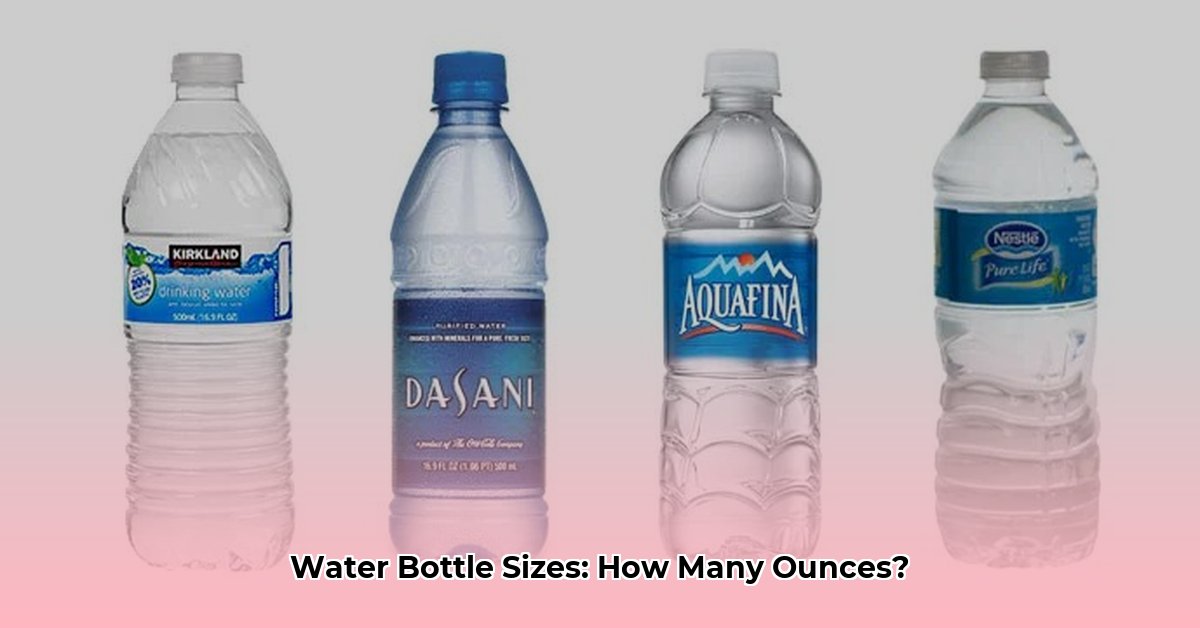You probably grab a water bottle without a second thought. But did you know those bottles come in a surprising range of sizes? While the familiar 16.9-ounce (500 ml) bottle is common, understanding different capacities is key for effective hydration. This guide breaks down everything you need to know about water bottle sizes, from tiny travel companions to hefty hydration heroes.
Decoding Water Bottle Sizes
Choosing the right water bottle is like finding the perfect pair of shoes—it needs to fit your lifestyle. Whether you’re a busy commuter or a seasoned athlete, understanding the different sizes available helps you find the perfect fit. This table highlights common sizes:
| Size (fl. oz.) | Size (ml) | Size (L) | Ideal For |
|---|---|---|---|
| 8 | 237 | 0.24 | Kids, small bags, short trips |
| 12 | 355 | 0.36 | Purses, briefcases, short commutes |
| 16.9 | 500 | 0.5 | Standard single-use bottles, everyday hydration |
| 20 | 591 | 0.59 | Moderate hydration needs |
| 24 | 710 | 0.71 | Popular reusable bottle size |
| 32 | 946 | 0.95 | Longer outings, higher fluid intake |
| 33.8 | 1000 | 1 | A full liter—great for active individuals |
| 64 | 1892 | 1.89 | Extended use, sharing, serious hydration |
| 128 (1 Gallon) | 3785 | 3.79 | Families, offices, maximum hydration |
Exploring Bottle Types
From disposable plastic to sleek stainless steel, the materials and designs of water bottles vary widely. Here’s a breakdown:
- Single-Use Plastic: Typically ranges from 8 to 24 ounces, convenient but less environmentally friendly.
- Reusable: A sustainable choice, available in stainless steel, glass, and durable plastic. Sizes vary widely, usually measured in milliliters or liters.
- Sports Bottles: Designed for easy access during physical activity, generally 20 to 32 ounces, often with specialized lids and features.
Measuring an Unmarked Bottle
Have a bottle without a size label? Here’s how to determine its capacity:
The Volume Method:
- Fill a measuring cup with a known volume of water.
- Pour the water into your unmarked bottle.
- Repeat until full, totaling the poured volume.
The Weight Method:
- Weigh the empty bottle.
- Fill the bottle with water and weigh it again.
- Subtract the empty weight from the full weight—the difference in ounces roughly equals the fluid capacity. For milliliters, multiply the ounces by 29.57.
Choosing the Right Size
The “perfect” size hinges on several factors:
- Activity Level: Intense exercise or hot weather necessitates larger capacities.
- Hydration Goals: Aiming for a gallon a day? A larger bottle might be ideal.
- Portability: Smaller bottles are convenient for travel and everyday use. Consider where you will mainly be using your bottle – at a desk or exercising?
- Refill Availability: Limited access to refills may require a larger bottle.
Metric Conversions at a Glance
- 1 ounce ≈ 29.57 milliliters
- 33.8 ounces ≈ 1 liter
Beyond the Basics: FAQs and Tips
What’s the ideal daily water intake?
Daily water needs vary. Factors like activity level, climate, and overall health influence how much water you should drink. Consult with a healthcare professional for personalized recommendations.
What are the benefits of staying hydrated?
Proper hydration is crucial for numerous bodily functions, including regulating body temperature, transporting nutrients, and removing waste. Some studies suggest adequate hydration can improve cognitive function and energy levels.
How do I maintain my reusable water bottle?
Cleaning your reusable water bottle regularly is essential. Check the manufacturer’s instructions for specific cleaning guidelines. Some materials, like stainless steel, can be washed in the dishwasher, while others, like glass, may require hand washing.
How can I make water more appealing?
Adding natural flavors like fruit slices, cucumber, or mint can enhance the taste of water. Infuser bottles are specifically designed to make this easy and enjoyable.
What about the environmental impact?
Single-use plastic bottles significantly contribute to environmental pollution. Switching to a reusable bottle is an eco-conscious choice that reduces plastic waste. Current research focuses on developing even more sustainable materials and manufacturing methods. Some studies also indicate that carrying a reusable bottle might lead to increased water consumption.
Conclusion: Hydration, Personalized
Understanding water bottle sizes empowers you to choose the best option for your individual needs. Whether you opt for a compact companion or a large-capacity vessel, staying properly hydrated is essential for your well-being.
- Wellness Fair Ideas for Work to Boost Employee Wellbeing - December 15, 2025
- Affordable Employee Wellness Fair Ideas for Any Budget - December 14, 2025
- Employee Wellness Programs Strategically Benefit Employee Health And Retention - December 13, 2025
















